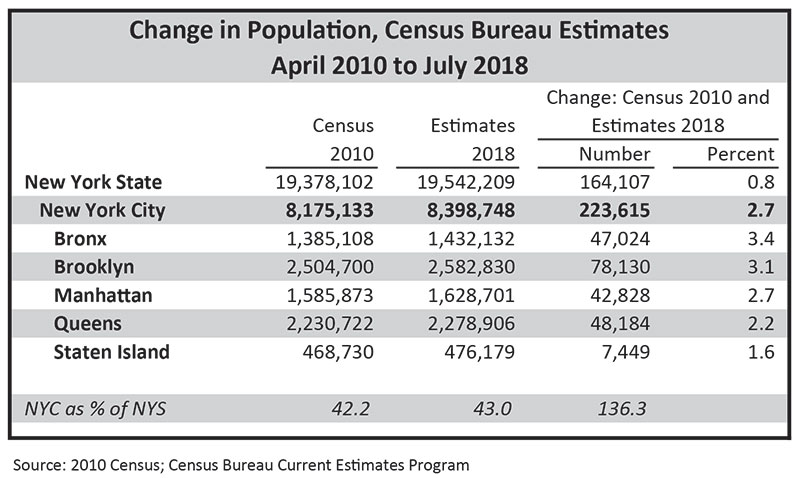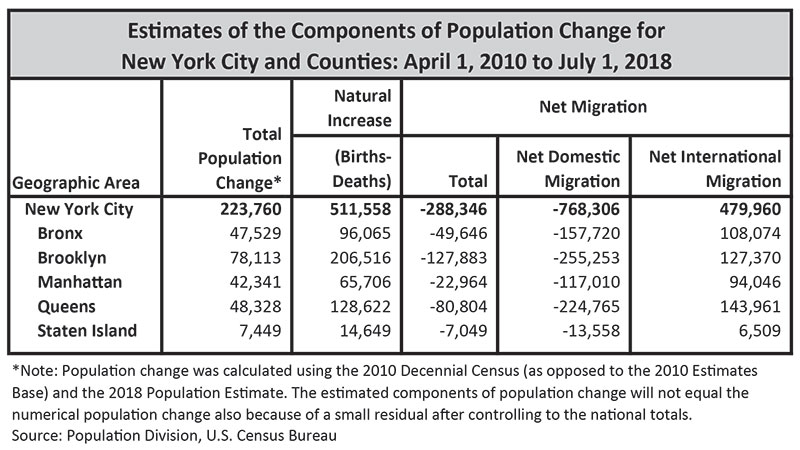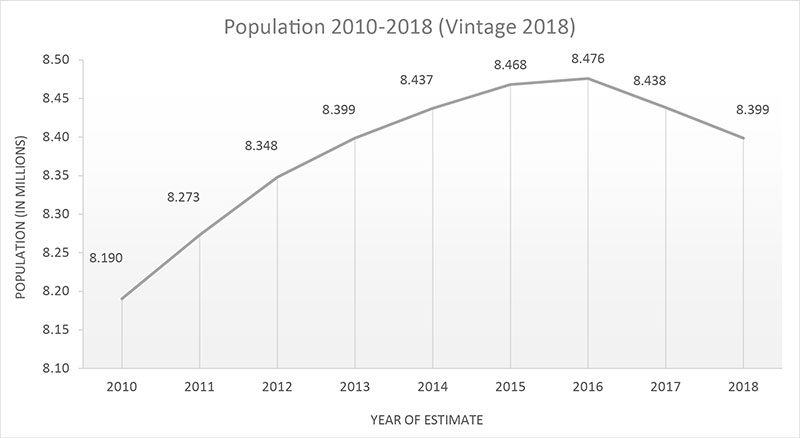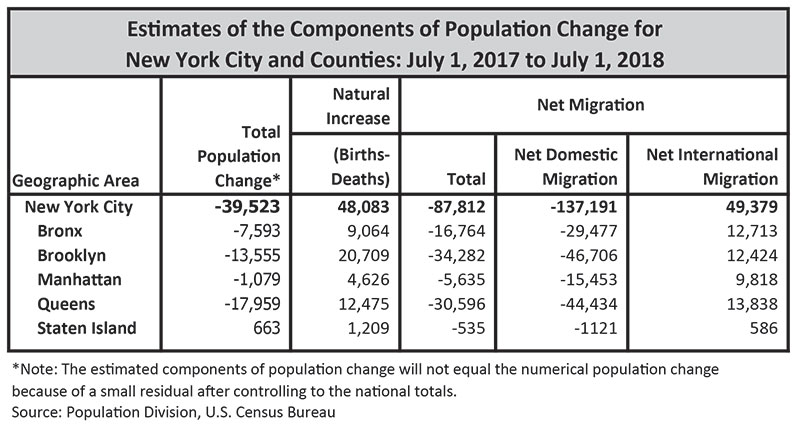The Repopulation the Application Was Not Properly Updated
Introduction
The U.S. Census Bureau prepares estimates of total population for all counties in the The states on an annual basis, using a demographic procedure known every bit the "administrative records method" (described beneath). This method assumes that mail-census population change can exist closely approximated using vital statistics data on births and deaths, along with other authoritative and survey data that provide a picture of migration patterns.
Total Population
According to U.S. Census Bureau population estimates, New York Metropolis's population increased from 8,175,133 in April of 2010 to 8,398,748 in July of 2018. This is an increase of about 224,000 residents over the 2010 mark, or ii.7 percent. Among the boroughs, the Bronx saw the largest modify in population in this 99-month flow, growing past 3.four percent or 47,000 persons, followed by Brooklyn (3.1 percent or 78,000 persons), Manhattan (2.seven percent or 43,000 persons), and Queens (2.ii percent or 48,000 persons). The lowest growth occurred in Staten Island (1.6 percent or seven,000 persons).
Although the metropolis grew past roughly 224,000 persons since 2010, New York State grew but by 164,000 people due to a population decrease of 60,000 for the counties exterior the urban center. Of the Country's 62 counties, 46 lost population.

Components of Population Change
Demographers divide population change into components.Natural increment represents the difference between births and deaths. Net migration represents the residual between persons inbound and leaving an area. Together, these components describe how populations modify over time. The U.S. Demography Agency constructs population estimates for all counties in the Usa past separately estimating the components of change. Births and deaths are compiled using information from the national vital statistics system. Net migration is a summation of two flows: migration of persons coming in from and leaving for other counties in the 50 states (net domestic migration) and the remainder of people who immigrate from and emigrate to other nations and Puerto Rico (net international migration). The internet domestic migration rate is derived using income taxation returns from the Internal Revenue Service and Medicare enrollment information from the Social Security Assistants. It is important to note that the estimation methodology for internet international migration has changed significantly, resulting in a revised 2010-2017 international migration estimate that is 31% lower than the previous vintage. While the previous vintage estimated international net migration for the city at 624,000, the latest vintage provides a lower estimate of 431,000 over the same flow, which are likely too depression. This has resulted in lowered overall population estimates for the metropolis, which now paint a dissimilar pic than the estimates issued just one year agone.
New York City has a very dynamic population, with several hundred one thousand people coming and going each year. This "churn" has long characterized the metropolis, and represents a fluidity that is hard to characterize using the internet migration measures presented herein. This dynamism is a testament to the city being a magnet for those seeking opportunities, and then moving on, only to be replaced by the next set of individuals aspiring for a amend life. This very vibrant picture is what makes New York Urban center's population extraordinary and unlike from most other places in the nation and, perhaps, the globe.
The most recent estimates from the U.S. Census Bureau point the following for the 2010-2018 period:
a) Positive natural increase—the surplus of births over deaths added 512,000 persons to New York City's population between April of 2010 and July of 2018.
b) In a return to its customary design of migration, New York City experienced a cyberspace loss through migration during the 2010-2018 period. This loss totaled 288,000 – the cyberspace result of domestic losses (768,000) offset by international gains (480,000).
c) Most of these migration losses were concentrated in Brooklyn (128,000), followed by net migration losses in Queens and the Bronx (81,000 and 50,000, respectively).

New Patterns of Recent Growth: 2017-2018 vs. 2010-2017
While the year-to-year changes provided by the Census Bureau'south population estimates program are tenuous, the chart below shows that growth in New York City was loftier in the initial role of this decade, slowed subsequently, and has experienced small declines since 2016. While we believe that population growth has slowed, the Census Agency's estimation methodology is not robust enough to precisely quantify the magnitude of these year-on-yr changes.

While we report year-to-year population change and components of alter for the 2017-2018 period, it is important to proceed in heed that these are estimates. Every bit noted earlier, due to the tenuous nature of population estimates, it is necessary to look at longer-term trends, equally opposed to short-term changes.


U.S. Census Agency Population Estimates Methodology
Each year, the U.South. Census Bureau produces estimates of the population for states, counties, cities and other places, too as for the nation equally a whole. They use data from multiple sources to estimate annual population alter since the last decennial demography. These population estimates use the 2010 Census counts as a base.
For each canton in the U.Due south., the Census Agency subtracts the annual number of resident deaths from the annual number of resident births to derive annual growth due to natural increase1 . Births are tabulated by residence of the mother, regardless of where the nascency occurred. Similarly, deaths are tabulated by the about recent residence of the decedent, not where the death occurred. Birth and expiry certificates from the National Center for Health Statistics are used as the data source.
Cyberspace International Migration is the issue of net flows to and from strange countries and Puerto Rico. These flows are sub-divided into three parts: immigration of the foreign-built-in, emigration of the strange- also equally native-born, and net migration betwixt the U.South. and Puerto Rico. Until this current set up of estimates, data from the American Community Survey "yr of entry" or "YOE" question was used to estimate clearing. The YOE question asks, "If you are born abroad, when did you lot come up to the U.Due south. to live?" For the vintage 2022 estimates, immigration was estimated using the "residence one year agone" or "ROYA" question which asks, "Where did you live one yr ago?" According to the Census Bureau, the use of a specific and timely reference bespeak in the ROYA question results in a more accurate pic of immigration to the U.Southward. But others, such as Jeff Passeltwo, have argued that while the ROYA question is conceptually cleaner, it understates the level of immigration, which tend to be lower than the YOE estimates across fourth dimension3.
Finally, the Census Bureau reworked the life tables underlying the estimation of emigration from the U.South., which has also resulted in lower net international migration for the post-2010 period, leading to lower overall population estimates. In general, emigration of the strange-born is estimated using the residual method. For example, the foreign-born population is aged forward to obtain the expected population in the year 2018. The expected population is so compared to the population estimated in the 2022 ACS. Subtracting the estimated from the expected populations provides the balance, which then serves as the basis of emigration rates for the foreign-born. For the native-born, emigration rates are based on research by Schachter (2008) using information from over 80 countries4. This work compares estimates of U.Southward. citizens living overseas measured for two consecutive fourth dimension periods and uses the difference to develop estimates of net native migration.
1 The data on births and deaths are generally considered to exist the most reliable part of the components of change analysis.
2 Jeffrey S. Passel, Pew Research Center, Presentation on "Contempo trends in international migration: Alternative methods, data sources and measures", 2022 Demographic Analysis Plan, Technical Workshop U.S. Demography Bureau, 2018.
3 Renuka Bhaskar, Belkinés Arenas-Germosén, and Christopher Dick, Population Segmentation, U.Southward. Census Bureau, Demographic Analysis 2010: Sensitivity Analysis of the Foreign-Built-in Migration Component, 2013
four Schachter, Jason. 2008. "Estimating Native emigration from the United states," Memorandum dated December 24, delivered to the U.S. Census Agency.
Source: https://www1.nyc.gov/site/planning/data-maps/nyc-population/current-future-populations.page
0 Response to "The Repopulation the Application Was Not Properly Updated"
Mag-post ng isang Komento